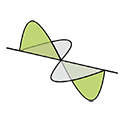General remarks - correlation between soil EC and crop yield
Before exploring the possibilities for different implement concepts, the relation between raw EC measurements, soil properties and crop yield have to be figured out.
Differences in soil properties are some of the most obvious reasons for yield variability. Soil EC has the potential to estimate variations in some soil physical properties in a field.
Yield maps are frequently correlated to apparent soil EC. In many situations, these similarities are explained through differences in soil. The water-holding capacity of the soil is a major factor affecting yield, and the yield map will likely show a strong correlation with the soil EC. In general, soil EC maps may indicate areas where further exploration is needed.
Most likely, soil EC maps give valuable information about soil differences and similarities, which makes it possible to divide the field into smaller management zones. Zones that have consistent EC readings are areas that have similar soil properties and can be grouped together for soil sampling and management.
Impact of soil water
The question regarding soil water that seems central to evaluating the usefulness of EC mapping in precision agriculture is: Does a field, mapped under different soil water conditions, display new zones due to changing field moisture conditions? As for soil EC maps to have value, the patterns and areas identified must be consistent and repeatable.
Various tests over several years have shown that fields mapped several times during the year with varying moisture contents displayed soil EC value changes but the zone delineation did not. Except for almost pure sand, due to variations in soil moisture content EC varies by only 5 to 10 percent. As a result, variations in soil zones and further more soil types can be detected, independent of the moisture conditions on the field.
Implement control in real time
Due to the above-mentioned strong dependency of raw EC and water-holding capacity, it is crucial that soil or seed applications are planned in due course of an EC survey to raise the full potential of these methods. An impacting time lag between survey and application can be avoided if survey and implement control are done at the same time or in other terms in real time.
As a rule of thumb, areas of higher conductivity indicate higher clay and cation exchange capacity (CEC), resulting in higher yield goals and additional inputs on those sites. In other regions, the higher conductivity indicates excessive clay, which may limit yield, thus reducing inputs. In both cases, soil EC identifies those sites and allows individual recipes to be created. For both sandy and clay soil, compaction has different impacts due to their different pore volume and CEC.
Topsoil Mapper for implement control
The Topsoil Mapper uses real time EC data to calculate relevant soil information and uses it on-the-fly to control an implement. As described, different soil types and soil properties need different application strategies. In terms of variable depth cultivation this means a variable application depth of the cultivator or subsoiler.
The Topsoil Mapper provides three predefined control setups which enable different cultivation strategies:
- Shallow Cultivation
- Subsoiling
- Depth Contour
Shallow Cultivation
The Shallow Cultivation setup is recommended for cultivation between 0 and 20 cm. It takes soil texture, CEC and pore volume related to soil compaction into account and controls the cultivator. The user can furthermore optimize the depth control, by teaching the implement control through his own expertise gained on different soil conditions on site. The „inverse“ button reverses the cultivation strategy.

Subsoiling
The Subsoiling setup is recommended for cultivation between 15 and ~60 cm and is in terms of functionality similar to the shallow cultivation program. It takes soil texture, CEC and pore volume related to soil compaction into account and controls the cultivator.
The user can furthermore optimize the depth control, by teaching the implement control through expertise on different soil conditions on site.

Depth Contour
The depth contour control follows a sub-surface contrast which appears for example when a compacted layer is covered by loosened topsoil layer or where different soil types are arranged vertically. The depth contour is limited only by the implements operating range.




